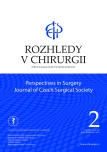Acute hemorrhagic cholecystitis as a rare cause of hemobilia
Authors:
M. Bockova 1; F. Pazdírek 1; J. Šťovíček 2; A. Stolz 1
Authors‘ workplace:
Chirurgická klinika 2. lékařské fakulty Univerzity Karlovy a Fakultní nemocnice Motol v Praze
1; Interní klinika 2. lékařské fakulty Univerzity Karlovy a Fakultní nemocnice Motol v Praze
2
Published in:
Rozhl. Chir., 2023, roč. 102, č. 2, s. 80-84.
Category:
Case Report
doi:
https://doi.org/10.33699/PIS.2023.102.2.80–84
Overview
Hemobilia is an unusual type of gastrointestinal bleeding most frequently due to iatrogenic injury, trauma, or neoplasia. Acute cholecystitis as a cause of hemobilia is rare. We present the case study of a patient with bleeding from eroded gallbladder mucosa in the setting of severe calculous cholecystitis. The hemorrhagic episode was preceded by acute ERCP due to obstructive icterus with extraction of the calculi, followed by the development of severe acute pancreatitis. These factors initially misled the diagnosis. The bleeding was not hemodynamically important and routine diagnostic methods did not reveal its exact source. Direct choledochoscopy (SpyGlassTM) proved to be helpful in determining the right diagnosis, as it ruled out any injury or tumor in the main bile ducts and considerably supported the assumption of intrabladder bleeding. Surgical revision confirmed the cause, and subsequent cholecystectomy solved the whole problem.
Keywords:
cholangioscopy – hemobilia – hemorrhagic cholecystitis – choledochoscopy – endoscopic intervention
Sources
1. Zhornitskiy A, Berry R, Han JY, et al. Hemobilia: Historical overview, clinical update, and current practices. Liver Int. 2019;39(8):1378−1388. doi: 10.1111/ liv.14111.
2. Šiller J, Havlíček K, Turnovský P, et al. Hemobilie, vzácná příčina krvácení do GIT. Rozhl Chir. 2008;87(2):89−91.
3. Murugesan SD, Sathyanesan J, Lakshmanan A, et al. Massive hemobilia: a diagnostic and therapeutic challenge. World J Surg. 2014;38(7):1755-62. doi: 10.1007/s00268-013-2435-5.
4. Chang CHW, Wu YH, Liu HL. Upper gastrointestinal bleeding with hemobilia caused by gallstones. J Emerg Med. 2020;58(5): e227-e229. doi: 10.1016/j. jemermed.2020.03.035.
5. Kim YCH, Park MS, Chung YE, et al. Gallstone spillage caused by spontaneously perforated hemorrhagic cholecystitis. World J Gastroenterol. 2007;13(41):5525−5526. doi: 10.3748/ wjg.v13.i41.5525.
6. Green MH, Duell RM, Johnson CD, et al. Haemobilia. Br J Surg. 2001;88(6):773−786. doi: 10.1046/j.1365- 2168.2001.01756.x.
7. Chin, MW, Enns R. Hemobilia. Curr Gastroenterol Rep. 2010;12:121–129. doi: 10.1007/s11894-010-0092-5.
8. Johnson KD, Perisetti A, Tharian B, et al. Endoscopic retrograde cholangiopancreatography- related complications and their management strategies: A „scoping“ literature review. Dig Dis Sci. 2020;65(2):361−375. doi: 10.1007/ s10620-019-05970-3.
9. Berry R, Han J, Girotra M, et al. Hemobilia: Perspective and role of the advanced endoscopist. Gastroenterol Res Pract. 2018;12;3670739. doi: 10.1155/2018/3670739.
10. Szary NM, Al-Kawas AH. Complications of endoscopic retrograde cholangiopancreatography: How to avoid and manage them. Gastroenterol Hepatol (NY). 2013; 9(8):496–504.
11. Vyhnánek F. Současný postup u poranění jater. Úraz chir. 2012;20(2):1−7.
12. Hoch J. An unusual combination of hemobilia and hemoperitoneum. Rozhl Chir. 1990;69(3):132−134.
13. Boston Scientific. SpyGlass™ DS Direct Visualization System [on line]. c2022 [cit. 2022-08-15]. Available at: https://www. bostonscientific.com/en-IN/products/ direct-visualization-systems/spyglass-direct- visualization-system.html.
14. Chen YK, Pleskow KD. SpyGlass single-operator peroral cholangiopancreatoscopy system for the diagnosis and therapy of bile-duct disorders. Gastrointest Endosc. 2007;65(6):832−841. doi: 10.1016/j. gie.2007.01.025.
15. Urban O, Arnelo U, Kliment M, et al. Cholangiopankreatoskopie pomocí Spy- GlassTM direct visualization system. Gastroent Hepatol. 2013;67(2):124−126.
Labels
Surgery Orthopaedics Trauma surgeryArticle was published in
Perspectives in Surgery

2023 Issue 2
Most read in this issue
- Maisonneuve ankle fracture
- Abdominal emergencies in surgical oncology
- Position of surgical treatment in step-up management of severe acute pancreatitis
- Borrelial pseudolymphoma of the eyebrow in an adult
